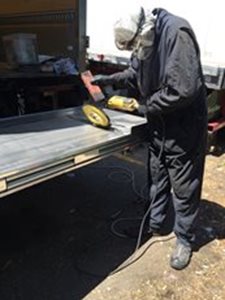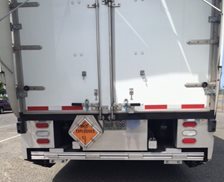 |
|
Bob getting started on the liftgate |
To get started we need plenty of space, free of any clutter that may cause a trip and fall, around our project. I polished the top of the lift-gate when it was folded, so sliding it out, lifting it into a comfortable working position and ensuring my area was clear was first in order. I then got some of my ppe on, eye protection and gloves, because I needed to do some sanding first. When I looked at doing the lift-gate the first time, I thought it would be an easy polish, and then I felt it. The lift-gate is made of extruded aluminum sections fitted together to make the platform. Everything extruded has extrusion marks on it, you may not be able to see them but if you tried to polish it they will show up. So I had to sand the extrusion lines out before I could start polishing.
Starting with the 220-grit sandpaper, I sanded until I could no longer see the extrusion lines, this is pretty coarse sandpaper and I could feel how "rough" it was. I did clean the project with fast drying solvent between the different grits of sandpaper. Proceeding with the other grits using them dry until I got to the 600 grit, where I got a squirt bottle of water to help keep the sandpaper clean and to help this process go faster. Going up in grit progression with the sandpaper all the way to 1000 grit or 1200 if you want. I used extreme caution with the water working with an electric sander, as I hate getting shocked. Aluminum will build up very fast in sandpaper because it is a soft metal. I did choose to not sand out all of the deep scratches as that would have taken a long time and after all it will come in contact with the ground, rocks, concrete and asphalt again and again, so polishing it is for me just so I can say I did it, I will keep it polished but it's not like you will see it in a drive-by.
As you will notice, the project gets shinier with each progression of sandpaper, not really shiny but you will be able to see images in the reflection, not clear but definable shapes and colors. This is where the polisher comes in to do the rest. Before we fire it up we need to finish getting dressed, coveralls, respirator and hood, you get the picture, cover up. Anything not covered will be black and it is aluminum oxide and the clay from the rouge, probably not good to ingest or to breath in.
Follow the directions to assemble your safety hub to the yellow wheel and to the drive adapter that will attach to the polisher spindle. Install drive adapter assembly onto the polisher and you are ready to begin. Get the red bar out of the package; I break the bars in half for easier handling. All the work of the wheel is done on it's edge not flat like a grinder, so before starting the polisher get the feel of holding it with the wheel on edge. Most polishers have a handle near the business end, to hang on to while working, that will move from one side to the other, I make sure that handle is pointing away from the project or up.
Most polishers have a locking trigger; I lock it on and control the polisher with one hand while holding the rouge bar in the other. This is probably not the safest thing to do but I have done it long enough and still grab the polisher for stability when not applying rouge to the wheel, do what you feel safe and comfortable with. There is no need to apply pressure as the wheel speed and the rouge will do the work. You are only there to control the machine and to apply rouge as needed. Polishing is a slow process that takes patience. The results show up as soon as you touch that spinning wheel to the aluminum, but take your time. I hold the polisher with the wheel to the left of the machine, the direction of rotation will throw most of the debris back at you, and so standing to the right of the machine will help keep you cleaner. That also means the top of the wheel is rotating towards the project, the top of the wheel is where you apply the rouge.
With the wheel spinning, not on the project at first, touch the rouge bar to the wheel, not much is needed but you will figure that out as you go. Ok, we have the wheel spinning and rouge on the wheel, let’s start at the bottom or closest edge to you. Remember, you are working with a spinning wheel at 3500 RPM; any edge is going to try to grab and pull that machine out of your hands. I start at the bottom because the direction of rotation will leave the project clean as you work your way up. Work in small areas that you can work without taking any steps or moving your feet. When you first touch the wheel to your project, you will see a black line of rouge appear at the leading edge of the wheel this is just ahead of where the wheel is working. This line also gives you a reference as to where you are working and a guide as to when to add more rouge.
I try to start in the lower left corner, using extra caution around edges, tilting the wheel so the debris is
thrown "over" the edge and so the edge will not grab the wheel. The wheel is spinning fast enough that if it grabs an edge it could pull the polisher out of your hands or if you have a good grip it could bend your project, either way is a bad thing, so be careful around edges. Working that small area I move left to right up about 1/2" then right to left, the rouge "stripe" should be about 1/4" wide, so moving up into that will give the wheel new rouge to work with. When the stripe gets smaller than 1/4" add more rouge by touching the bar to the spinning wheel, this can be done while the wheel is still working on the project.
Stop the wheel every few minutes and look at it, if it looks like it has a silver color it needs to be cleaned. I try to clean my wheel every few minutes; it will get rid of excess rouge and the aluminum that builds up. There are a couple of ways to do this, first (recommended) is to purchase a wheel cleaning tool called a Buff Rake, I don't have one of these. Second, is to use an old flat blade screwdriver, as the wheel is spinning run the point of the screwdriver into the edge of the wheel and it will clean up the wheel, I used to do this and ruined a couple of good screwdrivers. Third, this is what I do if there is concrete near, just run the spinning wheel on the clean concrete; it will clean that wheel right up. If you have an old rasp file that will work also. Add rouge before going back to polishing. Keep working back and forth from bottom to top overlapping each pass till you reach the top edge, remember what I said about edges, put down the rouge bar and use both hands with a tight grip on the polisher use caution around the edges.
 |
|
What lift gate looks like tucked away |
Once you have finished the entire project it should be pretty shiny. You have two choices now, one is to leave it alone and be happy with what you have, or you can do it all over again with the yellow wheel and the red bar before proceeding to the next step using the white wheel and bar. It goes much faster each time you do it. For me I do it twice with the red bar then change to the white wheel and bar. I have gone over the project as many as six times with the white wheel and bar, each time the project gets more mirror like, and it is noticeable as soon as you start again. But time is a factor in everyone’s lives and you get tired and you are dirty. There's always another day. Lets do the final liquid polish, following the directions on the bottle and using a good quality towel to apply and a microfiber cloth to remove the polish, buff to a mirror shine with a clean microfiber cloth and you're done. Polished aluminum does need some maintenance though; the liquid polish you used will do just fine for that.
This is a general idea of how I polished my lift-gate, lower rail and box corners. I am not a professional polisher and I'm sure there are things I do or don't do that a pro would or wouldn't. This did get my stuff pretty shiny and will probably work for you too if you decide to do your own polishing. I have invested about $400 in equipment, the supplies; I just keep replacing them as needed. I have been polishing my own aluminum for about 10 years and have made many mistakes. I have learned many things and tricks by asking those who sell polishing products at trucking shows and asking professional polishers. It is definitely a labor of love that is not for everyone. While we are sitting waiting for that next load to pickup it gets me out of the truck and I get some exercise.
Using the polisher to maintain the polished aluminum is easier than doing it by hand, but you do get dirty. The polisher can also be used to polish the paint with the right attachments. I believe most polishers come with the pads to do paint, as that is primarily what they are sold for, just need different polishing compounds. I don't think you will get as dirty doing the paint, so if you get the equipment, give it a try and don't like polishing the aluminum you can polish the trucks paint. Anyway have fun drink plenty of fluids and make things shiny.